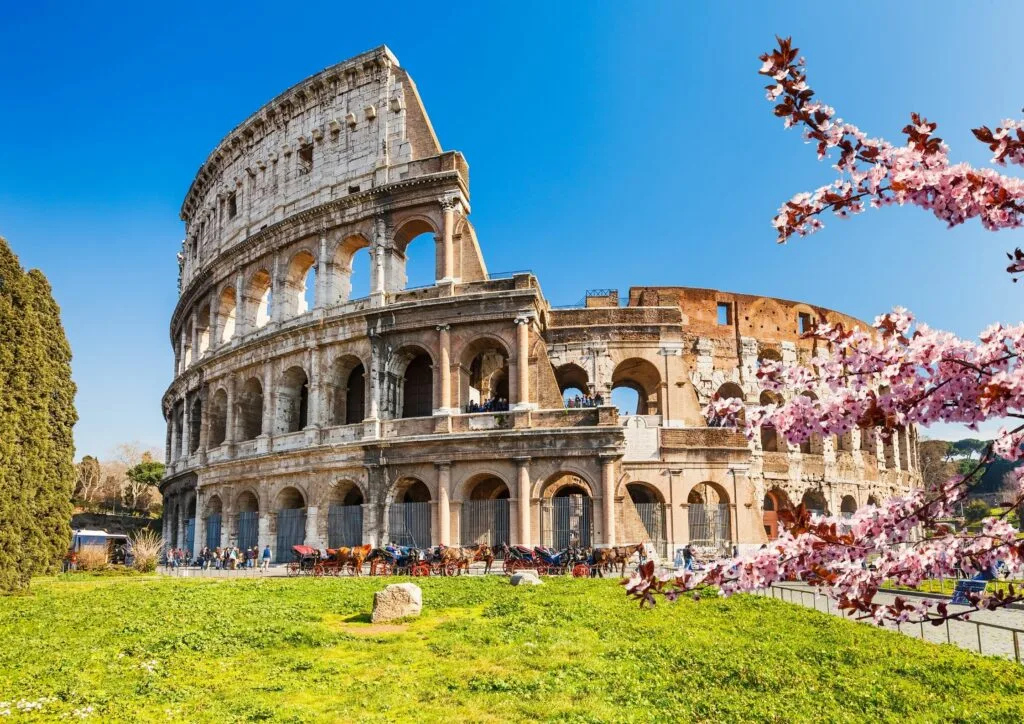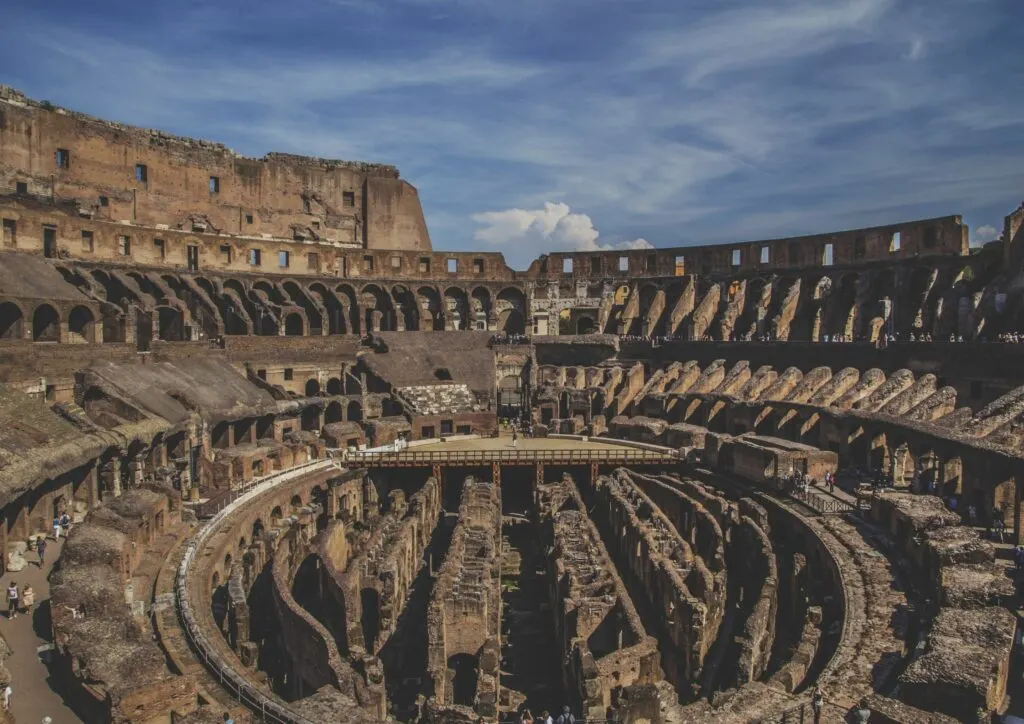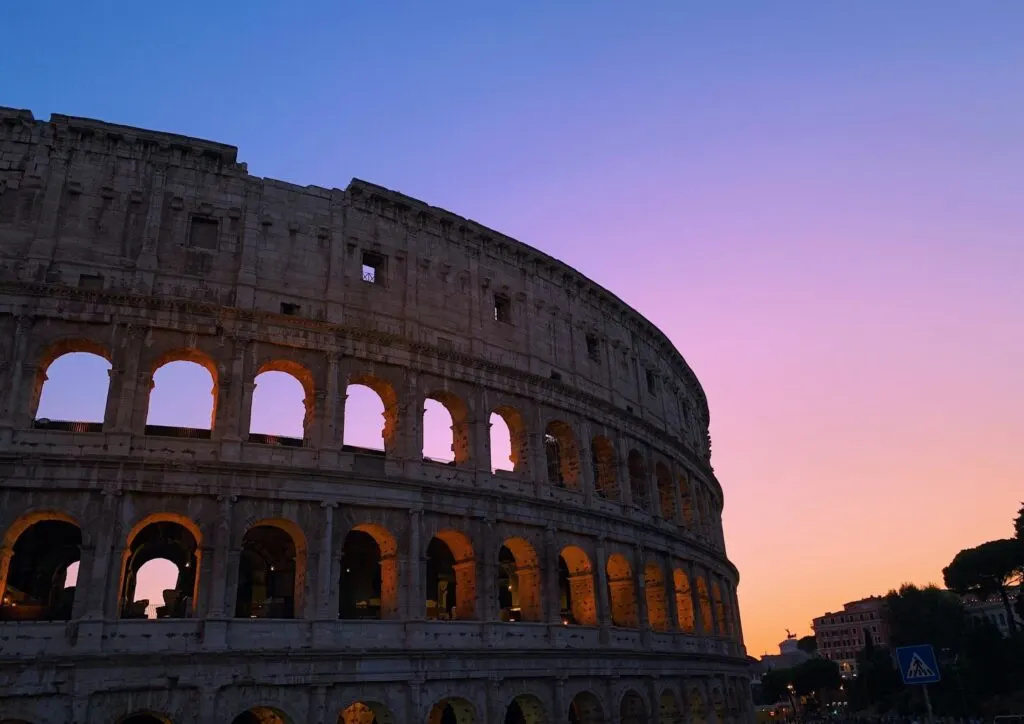The grandest example of ancient Rome’s architectural ingenuity, wealth, imperialism, and hierarchical society, the Colosseum, is the largest, free-standing amphitheatre in the world today as it was in the ancient world.
In this article, we will unravel everything you need to know about this awe-inspiring structure, its bloody history, and its influence on the modern world.
What is the Colosseum Famous For?

Today, the Colosseum is famous for its architectural brilliance and painful history. It’s one of the few structures that have survived the test of time. In the era of the Roman Empire, the Colosseum was famous for gladiatorial fights, animal hunts, and the public execution of criminals, which, by the way, was the Roman definition of entertainment.
Click here to check out other amazing places to include in your Italy Itinerary
History of The Colosseum
The Colosseum was a place of death for some, and for others, it was a place of amusement; the blood-soaked arena provided Romans with a much-needed distraction from their difficult lives.
Often placed on the level of the architectural genius of the pyramids, the Colosseum is the most spectacular symbol of ancient Rome. Constructed in 70 AD, this structure inspires curiosity, wonder, and disbelief.
Despite what went on inside its walls, the Colosseum is an engineering marvel. Its brilliance is yet to be surmounted, and the violence it spewed can shock the most hard-hearted.
Structure
The Colosseum is 189 metres long and 156 metres wide, with a base area of 24,000 square metres; the site was previously occupied by a lake built by Emperor Nero. The outer wall of the building was 48 metres in height, while the original perimeter had a scope of 545 metres.
The oval central area, surrounded by a 5-metre tall wall, had a length of 87 metres and a width of 55 metres. Right outside the wall was where the seating of the Colosseum began.
To avoid floods, the drains were built 8 metres below ground, and they carried water out into the sanitation system of the city. The depth of the foundation varies depending on where you are in the Colosseum – the foundation of the seating area was about 12 to 13 metres, and the foundation of the arena was about 4 meters.
About a million tons of concrete were used to build this grand structure, all of which were held fast by 300 tons of iron clamps. The Colosseum is the blueprint for many stadiums we see around the world today. If we were to build the Colosseum today, it would cost nearly USD 1 billion.
Seating
The seating of the Colosseum is an interesting and revealing aspect, to say the least. There were 80 passageways in the building, which were called vomitoria, meaning “rapid discharge” – this is where the English word vomit comes from. Seventy-six of these passageways were used by ordinary people, and four passageways were used by the elite.
The seating consisted of four tiers representing the social classes of Roman society. The first tier – the closest to the arena, thus providing the best view – was reserved for the emperor, the vestal virgins, and the senatorial members; the second tier was dedicated to the wealthy noblemen; the third tier was meant for the ordinary citizens, and the fourth tier was reserved for slaves and women.
Also, to provide shade for the spectators, there was a massive awning; the topmost tier representing the lowest social class got the best shade, which was an unintended perk for the downtrodden of Roman society.
You might be interested in 7 Wonders of the World
What Was Under the Colosseum Floor?

Under the Colosseum floor was a tunnel system called the hypogeum, which was built by Emperor Domitian – he also built the topmost tier to add more seating capacity to the structure.
The hypogeum consisted of two floors, upon which wild animals, slaves (who worked behind the scenes to bring about the spectacles) and the gladiators were held.
There were elevators that brought animals and gladiators onto the arena. There’s also evidence to suggest that there was a hydraulic system.
What Was it Like to be a Spectator in the Colosseum?
The air was permeated with blood and sweat as Romans gathered in the Colosseum and took their seat at the allotted place to watch the gladiatorial combats, battle enactments, and animal hunts.
Spectators were given free snacks and wine; when it was hot, they would be sprayed with scented water. This sounds fun and jovial, but the exact opposite happened in the arena.
During lunch intervals, people who were condemned to death would be thrown onto the arena to be eaten alive by wild animals, and slaves would be killed for sport – most criminals who were sentenced to death would kill themselves before reaching the arena to escape being torn apart by animals.
Gladiators would fight to the death, and animals would be goaded and killed. It is said that over 50,000 people and thousands of animals were killed in the arena for the sake of entertainment.
These acts would continue for four centuries, but they came to an end as people grew sympathetic to the suffering of others. The Colosseum became a completely different place after the fall of Rome, which happened in 476 AD.
The last recorded gladiatorial combat was held in 435 AD, but the animal hunts continued until 523 AD.
The Abandonment
After the fall of Rome, the Colosseum was all but abandoned. During the 6th and 7th centuries, the Colosseum was used as a chapel, and part of the building was used as a cemetery; the place also provided housing and a site for workshops. From the 14th to the 19th century, a religious order inhabited the Colosseum.
Why is the Colosseum Broken?
The Colosseum saw several structural changes throughout history. In 217 AD, a fire destroyed parts of the building, and it was not restored until 240 AD. After the place was abandoned, stones, marble, and iron clamps were looted.
The earthquake in 1349 did the most damage; half of the outer wall collapsed. Until around the 17th century, the rubble was used for other projects in the city – some marbles from the Colosseum were used for Saint Paul Basilica.
Who Really Built the Colosseum?
Vespasian built the Colosseum, but his son, Titus Caesar Vespasianus, took over the project after Vespasian died in 79 AD.
The inauguration of the Colosseum was a grand affair that lasted for 100 days – Titus killed around 9,000 wild animals during the inaugural games.
Why Was the Roman Colosseum Built?
The Colosseum was built by Emperor Vespasian to sway the public displeasure directed at the ruling class, which was a result of the lavish lifestyle of Emperor Nero. The Colosseum was actually a vanity project fuelled by Vespasian’s need to showcase Rome’s ever-increasing imperial capacity and wealth.
However, he managed to convince the public that this was actually for the good of the people, which was, for the most part, true as it was meant to provide entertainment for the public.
The wealth required to build the Colosseum was sourced from Jerusalem during the First Jewish-Roman War; Jewish people were taken as slaves; some were put to work in the Colosseum, and others were sold.

Tourism Around the Colosseum
The Colosseum is one of the most visited tourist attractions in the world. The site attracts over six million people every year. Visitors need to buy tickets to enter the Colosseum and if you visit during the peak season, expect to wait in long queues at the ticket counter.
The best time to visit would be early in the morning or late in the evening at sunset before it closes. Also, it would be best if you had at least an hour to explore and take pictures of this magnificent structure.
Frequently Asked Questions
What Are Three Interesting Facts About The Colosseum?
- The Colosseum was built at the site of the Domus Aurea, meaning Golden House: this was a palace that belonged to Nero, who was notorious for his extravagant and decadent lifestyle.
- The Colosseum is also called the Flavian Amphitheatre, but the name Colosseum is more popular and derived from a large statue of Nero, which was inspired by the Colossus of Rhodes.
- The Colosseum could seat 50,000 to 80,000 people and is one of the New Seven Wonders of the World.
Were There Lions in the Colosseum?
Yes, there were lions. There were also tigers, bears, elephants, cows, zebras, ostriches, gazelles, leopards, wild goats, eagles, giraffes, falcons, hyenas, rabbits, hippos, and boars. All these animals were kept in cages under the arena floor, the hypogeum.
These exotic animals were brought from the far reaches of the world into the city not only for entertainment but also as a display of Rome’s imperial reach.
How Long did it Take to Build the Colosseum?
From 70 AD to 80 AD, it took ten years to build the Colosseum.

